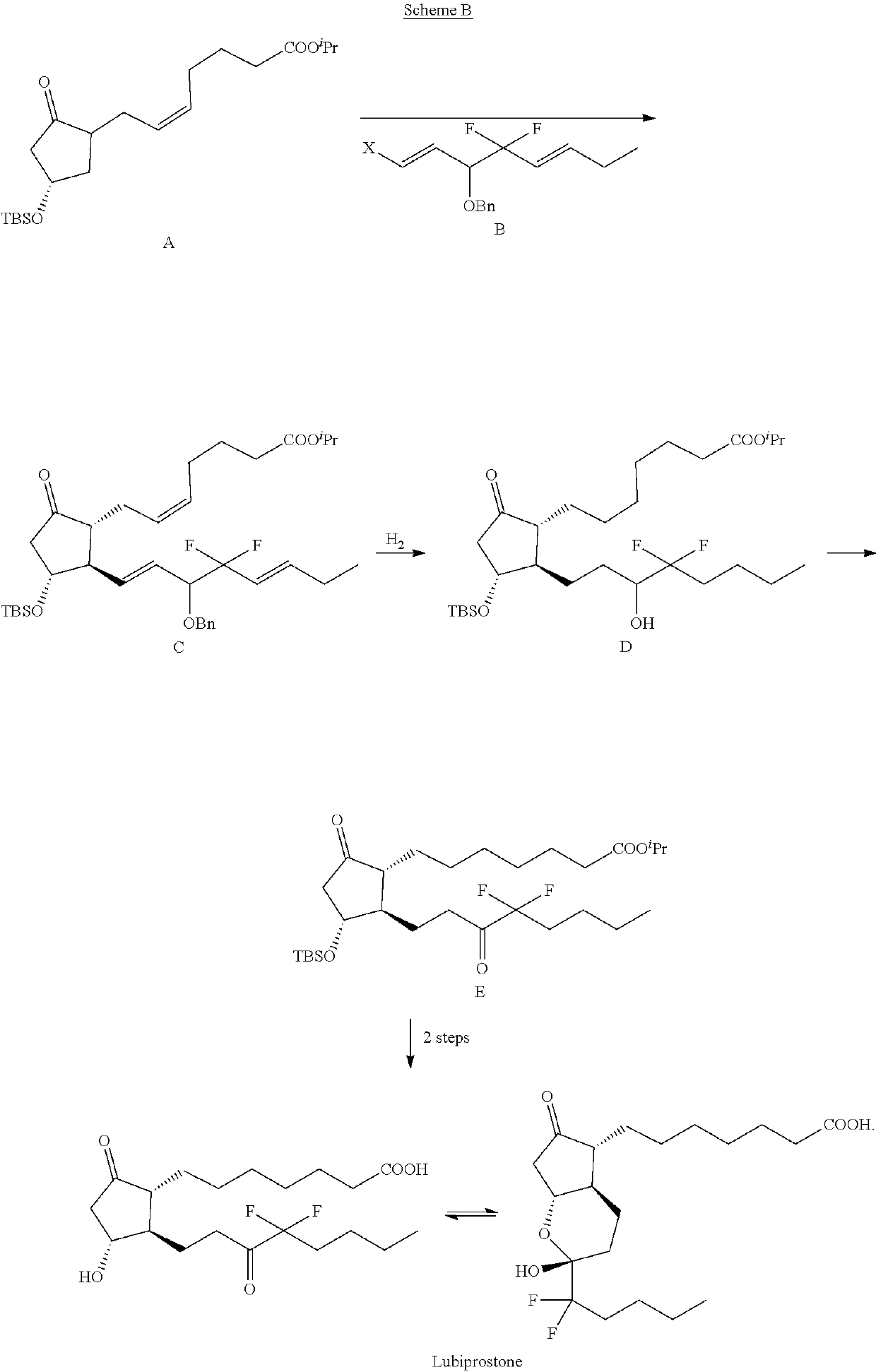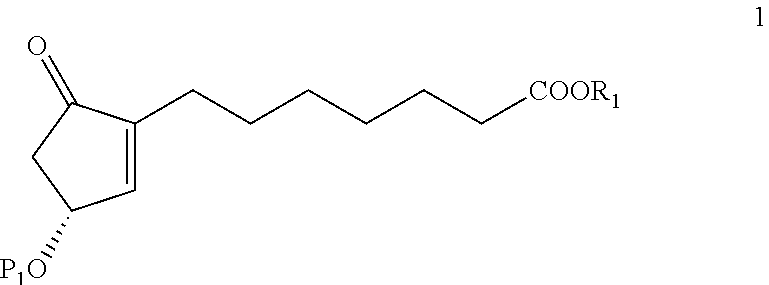Process for the preparation of Lubiprostone and intermediates thereof
a technology of lubiprostone and intermediates, which is applied in the field of new intermediates of lubiprostone, can solve the problems of large amount of expensive hydrogenation catalysts that must be used under high pressure and high temperatures to reduce all double bonds, and it is almost impossible to completely remove the hydrogenation by-products by using a silica gel chromatography method. high purity and high yield
- Summary
- Abstract
- Description
- Claims
- Application Information
AI Technical Summary
Benefits of technology
Problems solved by technology
Method used
Image
Examples
example 1
Ethyl 4,4-difluoro-3-oxo-octanoate
[0036]
[0037]A 20-liter four-neck flask was flame dried and cooled down under nitrogen. Diisopropylamine (585 g, 5.78 mol) in 4.7 L dry tetrahydrofuran was added to the reaction flask, followed by dropwise addition of n-butyl lithium (3.6 L, 1.6 M in hexane) at −70° C. and stirred for 1 h. Then, ethyl acetate (509 g, 5.78 mol) was added to the lithium agent slowly. After 30 minutes, ethyl 2,2-difluorohexanoate (520 g, 2.89 mol) was added to the reaction flask at −70° C. The reaction mixture was stirred for 30 minutes and the reactivity was checked by using thin layer chromatography (TLC). The mixture was quenched with 5 L saturated ammonium chloride aqueous solution and stirred for 10 minutes. The mixture was phase separated and the aqueous layer was extracted with 1 L toluene. The organic layer was dried over anhydrous magnesium sulfate and the solid was filtered off. The solvent was evaporated off under vacuum to give 875 g crude ester product.
[003...
example 2
4,4-Difluorooctane-1,3-diol
[0040]
[0041]Sodium borohydride (253 g, 6.69 mol) was added to dissolve the crude ester product of Example 1 (875 g) in 4.5 L ethanol at ambient temperature. The reaction mixture was stirred for 2 h and the reactivity was checked by using TLC. Then, the reaction mixture was adjusted to a neutral solution with aqueous 3N hydrochloric acid. The aqueous solution was concentrated and ethanol was removed. The aqueous solution was extracted with 2.5 L ethyl acetate twice. The organic layer was evaporated off under vacuum. The crude 1,3-diol product was purified by chromatography on silica gel using a mixture of hexane and ethyl acetate as a gradient eluent. Yield of the 1,3-diol compound was 306 g (58%, two steps).
[0042]1H-NMR (CDCl3): δ 3.760˜3.893(m, 5H), 1.678˜1.922(m, 4H), 1.291˜1.505 (br s, 4H), 0.897 (t, 3H)
[0043]13C-NMR (CDCl3): δ 123.997 (t), 71.396 (t), 60.040, 32.040 (t), 31.561, 23.379 (t), 22.461, 13.777
example 3
4,4-difluoro-1-iodooctan-3-ol
[0044]
[0045]A 12-liter four-neck flask was flame dried and cooled down under nitrogen. 4,4-difluorooctane-1,3-diol of Example 2 (607 g, 3.33 mol) in 6 L dry THF was added to the reaction flask. Imidazole (803 g, 11.8 mol) and triphenyl phosphine (2.2 kg, 8.4 mol) were also added into this flask. In the homogenous mixture, iodine (2.56 kg, 10.1 mol) was added to the reaction flask at 0° C. and continuously stirred for 3 h. Then, the reaction mixture was quenched with 20% aqueous Na2S2O3, and 3 L ethyl acetate was added and stirred for 30 minutes. The reaction mixture was phase separated. The organic layer was dried over anhydrous MgSO4, the solid was filtered off, and the solvent was evaporated under vacuum. The crude iodo product was purified by chromatography on silica gel using a mixture of hexane and ethyl acetate as a gradient eluent. Yield of the iodo compound was 737 g (75%),
[0046]1H-NMR (CDCl3): δ 3.858 (q, 1H), 3.363˜3.406 (m, 1H), 3.267˜3.319 (m...
PUM
| Property | Measurement | Unit |
|---|---|---|
| temperature | aaaaa | aaaaa |
| temperature | aaaaa | aaaaa |
| chemical | aaaaa | aaaaa |
Abstract
Description
Claims
Application Information
 Login to View More
Login to View More - R&D
- Intellectual Property
- Life Sciences
- Materials
- Tech Scout
- Unparalleled Data Quality
- Higher Quality Content
- 60% Fewer Hallucinations
Browse by: Latest US Patents, China's latest patents, Technical Efficacy Thesaurus, Application Domain, Technology Topic, Popular Technical Reports.
© 2025 PatSnap. All rights reserved.Legal|Privacy policy|Modern Slavery Act Transparency Statement|Sitemap|About US| Contact US: help@patsnap.com



